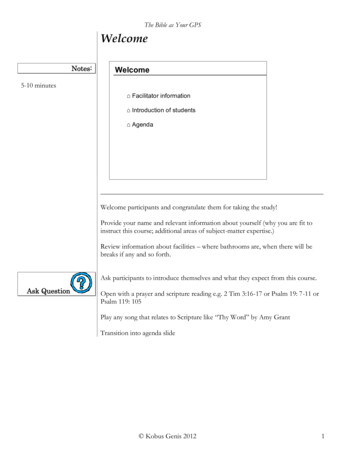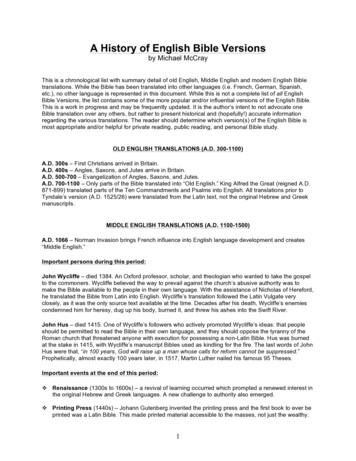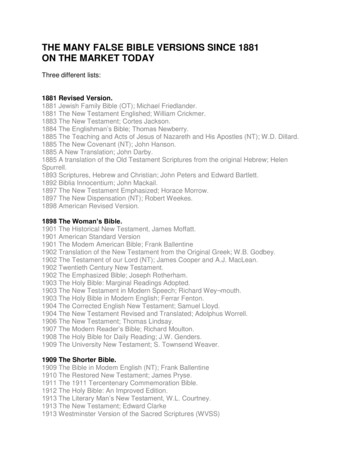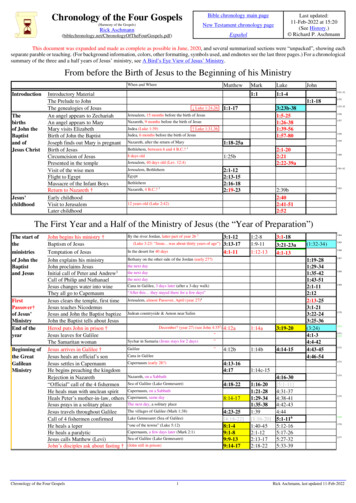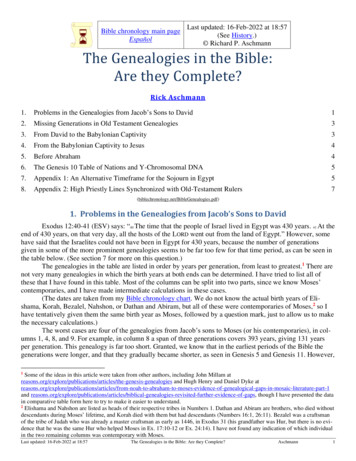
Transcription
Bible chronology main pageEspañolLast updated: 16-Feb-2022 at 18:57(See History.) Richard P. AschmannThe Genealogies in the Bible:Are they Complete?Rick Aschmann1.Problems in the Genealogies from Jacob’s Sons to David12.Missing Generations in Old Testament Genealogies33.From David to the Babylonian Captivity34.From the Babylonian Captivity to Jesus45.Before Abraham46.The Genesis 10 Table of Nations and Y-Chromosomal DNA57.Appendix 1: An Alternative Timeframe for the Sojourn in Egypt58.Appendix 2: High Priestly Lines Synchronized with Old-Testament . Problems in the Genealogies from Jacob’s Sons to DavidExodus 12:40-41 (ESV) says: “40 The time that the people of Israel lived in Egypt was 430 years. 41 At theend of 430 years, on that very day, all the hosts of the LORD went out from the land of Egypt.” However, somehave said that the Israelites could not have been in Egypt for 430 years, because the number of generationsgiven in some of the more prominent genealogies seems to be far too few for that time period, as can be seen inthe table below. (See section 7 for more on this question.)The genealogies in the table are listed in order by years per generation, from least to greatest.1 There arenot very many genealogies in which the birth years at both ends can be determined. I have tried to list all ofthese that I have found in this table. Most of the columns can be split into two parts, since we know Moses’contemporaries, and I have made intermediate calculations in these cases.(The dates are taken from my Bible chronology chart. We do not know the actual birth years of Elishama, Korah, Bezalel, Nahshon, or Dathan and Abiram, but all of these were contemporaries of Moses,2 so Ihave tentatively given them the same birth year as Moses, followed by a question mark, just to allow us to makethe necessary calculations.)The worst cases are four of the genealogies from Jacob’s sons to Moses (or his contemporaries), in columns 1, 4, 8, and 9. For example, in column 8 a span of three generations covers 393 years, giving 131 yearsper generation. This genealogy is far too short. Granted, we know that in the earliest periods of the Bible thegenerations were longer, and that they gradually became shorter, as seen in Genesis 5 and Genesis 11. However,1Some of the ideas in this article were taken from other authors, including John Millam nesis-genealogies and Hugh Henry and Daniel Dyke aps-in-mosaic-literature-part-1and -genealogies-revisited-further-evidence-of-gaps, though I have presented the datain comparative table form here to try to make it easier to understand.2Elishama and Nahshon are listed as heads of their respective tribes in Numbers 1. Dathan and Abiram are brothers, who died withoutdescendants during Moses’ lifetime, and Korah died with them but had descendants (Numbers 16:1, 26:11). Bezalel was a craftsmanof the tribe of Judah who was already a master craftsman as early as 1446, in Exodus 31 (his grandfather was Hur, but there is no evidence that he was the same Hur who helped Moses in Ex. 17:10-12 or Ex. 24:14). I have not found any indication of which individualin the two remaining columns was contemporary with Moses.Last updated: 16-Feb-2022 at 18:57The Genealogies in the Bible: Are they Complete?Aschmann1
this genealogy of Levi was after the time of Abraham, and people were amazed that Abraham had a son at theage of 100, so it is clearly too short. Column 4 is similar, except that Aaron was three years older than Moses.The genealogies in columns 1 and 9 are also similar, though we only have approximate birth years for Korah,Dathan, and Abiram.Passage(s)Jacob’ssons toDavid3Jacob’ssons toMoses3MosestoDavid3GenerationsYears elapsedYears/generationGenerationsYears elapsedYears/generationGenerationsYears elapsedYears/generationSons of JacobGrandsons of Jacob1Levi toHeman(Samuel’sgrandson)1 Chr.6:33-38(Num. arContemporaries of MosesKorahborn:1526?Contemporaries of uelJoelHemanborn:1040?2JosephtoJoshua3Levi toAsaph (theGershonites)1 Chr.7:22-271 Chr.6:39-431142438.6938943.22 i toAaron toZadok (Highpriests)Ezra 7:2-51 Chr. 6:1-8,50-531387967.6339013010 (or 11)48948.9 (or 44.5)Leviborn:1919Kohath5LevitoEthan (theMerarites)1 ubZadokborn:1040?1040?1 onRam (or 26?639265.3Leviborn:7JudahtoDavidLuke 3:31-33Ruth 4:18-20Matthew 1:2-610 (or 11)87787.7 (or 79.7)5 (or 6)39278.4 (or ichaelShimeaBerekiah6JudahtoBezalel1 Chr. 6:1-3Ex. 6:16-209ReubentoDathan an Another genealogy shown in the table that is only a little less problematic is column 7, the 10 generations from Judah to David in Ruth 4:18-20 (also included in the genealogy of Jesus in Matthew 1), with an average of 87.7 years per generation. (In Luke 3:33 Ram is called Arni, and an additional generation is added withAdmin.4 Even so, this only brings each generation down to 79.7 years. These variations are marked in red in thetable, and the most complete passage is also marked in red.)3Or contemporaries.This is according to the English Standard Version and Aland, Barbara et al. The Greek New Testament, Fourth Revised Edition. TheNew International Version has “Amminadab, the son of Ram”, and says in a footnote, “Some manuscripts Amminadab, the son ofAdmin, the son of Arni; other manuscripts vary widely.”4Last updated: 16-Feb-2022 at 18:57The Genealogies in the Bible: Are they Complete?Aschmann2
The genealogy in column 6 is similar to column 7, except that it only covers the time from Judah toBezalel, a contemporary of Moses.However, the 9 generations from Joseph to Elishama in 1 Chr. 7:22-27 suggest that the 430 year periodis quite reasonable, since the average number of years per generation is only 43.2.5Looking at the larger timespan from Jacob’s sons to David and his contemporaries, the 21 generationsfrom Levi to Heman (grandson of the prophet Samuel and a contemporary of David) give an average number ofyears per generation of only 41.9 years. However, Asaph and Ethan, who worked with Heman, have muchshorter genealogies, with many more years per generation.Finally, if we only look at the second time span, from contemporaries of Moses to David and his contemporaries, we find that in column 1 Heman’s genealogy only has 27 years per generation, much lower thananything else in the table.The high priestly line6 from Aaron (brother of Moses) to Zadok contemporary of David7 in Ezra 7:1-5 isa continuation of the Levi to Moses / Aaron list, but has far fewer years per generation, only 48.9 (or 44.5), butthis is much higher than Heman’s genealogy for the same period. (The same list appears in 1 Chr. 6:3-8, butwith one name missing, Azariah.)The column 6 genealogy from Nahshon to David is no better for this timespan than for the earlier one,actually much worse, with 97 years per generation.2. Missing Generations in Old Testament GenealogiesSo what is going on here? Simply that in most or all of these genealogies some of the generations havebeen left out, most notably in the genealogies on the right side of the table above. This was a common practice,and was well understood by the original readers. However, the two genealogies on the left are probably fairlycomplete, though even here some generations may have been left out.This has big implications for the ancestry of David and the dating of the events in the book of Ruth. Atfirst glance it appears from the genealogies of David that Boaz is David’s great-grandfather, and this wouldmake us look for the famine mentioned in Ruth sometime around 1100. This famine was probably not causedby the weather, since it did not affect Moab, but instead was probably the result of one of the oppressions mentioned in Judges, in which the oppressors confiscated food supplies. Around 1100 the Ammonite oppression inJudges 10:6-9 would be the most likely. However, when we realize that generations must be missing from thisgenealogy, and that Boaz may have been only two generations away from the Exodus from Egypt, we realizethat he may have lived much earlier, making us look for an earlier time of oppression, possibly that of the Moabites themselves, which might explain why Elimelech and Naomi moved to Moab in the first place. Thiswould also explain why, if Samuel wrote the book of Ruth as tradition suggests, some of the customs were already unknown to his readers (see Ruth 4:7).3. From David to the Babylonian CaptivityAbove we saw that in the first section of the genealogy of Jesus in Matthew 1, specifically the part fromJudah to David, many generations must have been left out. It turns out that this is true for the other two sectionsas well.It says in Matthew 1:17 that there were 14 generations from David to Jeconiah, but actually we knowthat this is not true, but that there were actually 18: the full list is found in 1 Chr. 3:10-16.8 These kings and theirdates are shown in my Bible chronology chart (1040-586 B.C.), and are thoroughly documented in the books ofWe get an even lower figure for years per generation if we include the next 2 generations up to Joshua, only 38.6. However, Joshua’sbirth year is unknown, and the one I have provided is perhaps higher than some estimate, so we probably shouldn’t consider this loweryears per generation figure to have much validity.6This shows the line of descent of the high priests, though not all of these actually held the office. See the appendix below for moredetails.72 Samuel 8:17.8It shows all of the generations, though not all of the kings, leaving out two of Josiah’s sons, Jehoahaz and Jehoiakim.5Last updated: 16-Feb-2022 at 18:57The Genealogies in the Bible: Are they Complete?Aschmann3
David to Jeconiah(Kings of Judah)1 Chr. 3:10-16Matthew 1:1718 (14)42623.7 (30.4)David born1041SolomonRehoboamAbijahAsaJehoshaphatJehoram (Joram)AhaziahJoashAmaziahUzziah akim born 633Jeconiah born615(Jehoiachin)Zadok to Jehozadak(High priests)1 Chr. 6:8-15Ezra 7:1-21140737Zadok born1040?Kings and Chronicles, so we know that this list is complete,one of the few genealogies for which we can be sure of that.Passage(s)Thus there are four generations left out in the Matthew list,Generationsthe red names in the list in the first column of the table on theYears elapsedYears/generationleft. Matthew was not trying to be deceptive, and in any case(contemporaries)he could easily be disproven by anyone who knew the OldTestament.Instead it is simply that Jesus’ legal genealogy inAhimaazAzariahMatthew 1 was designed to have three sections of 14 to aidJohananin memorizing it, rather than including each and everyAzariahAmariahgeneration.AhitubSo, with the complete genealogy, we see that theZadokShallumaverage number of years per generation is less than 24, aboutHilkiahwhat we would expect for vigorous kings who married fairlyAzariahyoung, but leaving out the four red names it would be 30.4.This suggests that even the more complete genealogies listedabove are incomplete.(contemporaries)Seraiah born633?(contemporaries)JehozadakIn the table I have also listed in the right column thecontinuation of the high priests’ genealogy for the same period for comparison. Here the average number of years per generation is much lower than in the first part of thelist, so this list could theoretically be complete, but in fact it is clear that it is not. We can tell this by trying tosynchronize the priests with the kings. However, the resulting chart is rather messy, so I have included it as anappendix at the bottom of this article.4. From the Babylonian Captivity to JesusIn the table below we have on the left the third section of the genealogy of Jesus in Matthew 1. In these12 generations the average number of years per generation is nearly 50 years, which, though not quite impossible, is extremely improbable.In Luke 3:23-38 we have another“Legal” Genealogy of Jesus“Human” Genealogy of Jesusgenealogy, shown on the right side of the table,Matthew 1:12-16Luke 3:23-38Jeconiahborn615Jesusborn 5?and this one is probably actually Mary’s, not JoShealtiel(Mary)SemeinEliezerseph’s. (Women were not normally included genealogies.) Thus it represents Jesus’ actualEliakimLeviJoananLevihuman bloodline, since he was Mary’s physicalAzorMelkiRhesaSimeonZadokJannaiZerubbabel Judahson, but had no human father.AkimJosephShealtielJosephThis genealogy is done in reverse, andEliudMattathias NeriJonamEleazarAmosMelkiEliakimhas 42 generations from David to Jesus, ratherMatthanNahumAddiMeleathan the 27 in the Matthew genealogy. And unJacobEsliCosamMennaJoseph born30?NaggaiElmadamMattathalike the Matthew genealogy, this genealogy isTotal years:585MaathErNathanprobably complete, since the average number of Per generation:48.8Mattathias JoshuaDavid born1041Total years:1036years per generation is less than 25.Per generation:24.7That being the case, does that mean allthe rest of the Luke genealogy is complete? No,it doesn’t: as seen above, the section from Judah to David is still missing many generations.5. Before AbrahamWhat about the genealogies before Abraham, from Adam to Abraham? Are they complete? The genealogies in Genesis 5 and in Genesis 10:11-32 are different from other genealogies in that they give age information, how long each individual lived, and how old each one was at the birth of his son. Because of this extra in-Last updated: 16-Feb-2022 at 18:57The Genealogies in the Bible: Are they Complete?Aschmann4
formation, many have claimed that these genealogies must be complete, and in fact have attempted to use themto calculate the exact year that Adam was created.However, as we have seen how genealogies are structured throughout the Bible, clearly this is not necessarily true, and there are in fact many good arguments that it is in fact not true. These arguments are ably setforth by other authors, including John Millam at sisgenealogies9 and Hugh Henry and Daniel Dyke at -in-mosaic-literature-part-110 , among manyothers. These articles also expand greatly on some of the genealogy questions I have discussed above.Millam discusses the fact that in the pre-Abrahamic genealogy in Luke 3:34-38, there is an additionalname not mentioned in the genealogies in Genesis 11, that of Cainan11. Based on this fact he states:Comparing the genealogy of Genesis 11 with Jesus’ genealogy in Luke 3, we find that Lukecontains the name Cainan between Shelah and Arphaxad (as noted earlier in this paper). The inerrancyof scripture, therefore, demands that there is at least one name missing in Genesis 11, and so atleast one of the two Genesis genealogies is telescoped. Despite this direct Biblical evidence, some stillhold to the belief that Genesis genealogies are complete, and hence that the inclusion of the name Cainan in Luke 3:36 is incorrect. One scenario would be that Luke based his genealogies on late copies ofthe Septuagint containing Cainan and so mistakenly added it to his genealogy. This scenario obviouslycontradicts Biblical inerrancy and so must be rejected. (Emphasis mine.)Thus, biblical inerrancy requires us to conclude that the Genesis 11 genealogy is incomplete!12 Both ofthe articles provide good arguments that not just one but many generations are missing. Thus, it is not possibleto determine the chronology of the Bible prior to Terah, father of Abraham, which is why my Bible chronologychart starts with Terah!6. The Genesis 10 Table of Nations and Y-Chromosomal DNAIn Genesis 10 a different kind of genealogy is provided, often called the Table of Nations. For a discussion of this, and how it may have a possible correlation with Y-Chromosomal DNA, see my article The Genesis10 Table of Nations and Y-Chromosomal DNA.7. Appendix 1: An Alternative Timeframe for the Sojourn in EgyptIn Exodus 12:40-41 some ancient versions (though not the Masoretic text, which is the most reliableHebrew text we have) add the words “and Canaan” after “Egypt” in verse 40, as is shown by the NIV text:“40 Now the length of time the Israelite people lived in Egypt [and Canaan]13 was 430 years. 41 At the end of the430 years, to the very day, all the LORD’s divisions left Egypt.” Presumably this is to avoid accepting the fact9Also found at circumcisedheart.info/Christian site/The Genesis Genealogies.doc.This is a five-part series, so be sure to go to the extreme bottom of each page to find the link to the next part. It is also found attnrtb.wordpress.com/2012/ s is not Canaan, the son (or descendant) of Ham, which in Hebrew is כִּ ַנעַן /kəˈnāʿan/ and in Greek Χανάαν [xaˈnaan], but anadditional name Cainan in the genealogy of Abraham in Luke 3:36 not included in the Masoretic text of the Old Testament, which inGreek is Καινάμ [kaiˈnam]. There is another Καινάμ listed later in the same genealogy (though earlier chronologically), in verse 37,11which corresponds to the Hebrew name קֵ ינָֽן /qêˈnān/ in Genesis 5:9,10. In most English translations this Hebrew name is translatedKenan, though in the King James Bible and some others it is translated Cainan. In any case the two Hebrew names are pronouncedvery differently, even though they are generally pronounced the same in English.12In his revised article at he-Genesis-Genealogies.pdf (also te-dr-john-millam/) he backs down somewhat from this conclusion, but I think hisinitial conclusion is valid. Reasons to Believe seems to agree, since it only has the old version of the article on their main site, thoughit does have a link to the new version.13NIV footnote: 12:40 Masoretic Text; Samaritan Pentateuch and Septuagint Egypt and CanaanLast updated: 16-Feb-2022 at 18:57The Genealogies in the Bible: Are they Complete?Aschmann5
that there must be missing generations in the genealogies from the sons of Jacob to Moses and hiscontemporaries.Interestingly, this would have the effect of cutting the time in Egypt exactly in half, since the figuresprovided in Genesis make it clear that Abraham’s family was in Canaan for exactly 215 years before moving toEgypt, as shown in my Bible chronology chart (see particularly the information with a green background).However, this seems to simply be a coincidence, and to have no larger implications.And at first glance it seems that this would resolve some of the numbers in the chart, as we can see inthis comparative chart of the numbers:Passage(s)Jacob’ssons toMoses3Jacob’ssons toMoses3GenerationsYears elapsedYears/generationGenerationsYears elapsedYears/generation1Levi toHeman(Samuel’sgrandson)1 Chr.6:33-38(Num. 16:1)3393131317859.32JosephtoJoshua3Levi toAsaph (theGershonites)1 Chr.7:22-271 Chr.6:39-43938943.2917419.34Levi toAaron toZadok (Highpriests)Ezra 7:2-51 Chr. 6:1-8,50-533390130317558.35LevitoEthan (theMerarites)1 Chr.6:44-476JudahtoBezalel1 Chr.2:3-20639265.3617729.57JudahtoDavidLuke 3:31-33Ruth 4:18-20Mat. 1:2-65 (or 6)39278.4 (or 65.3)5 (or 6)17735.4 (or 29.5)8LevitoMoses1 Chr. 6:1-3Ex. 6:16-209ReubentoDathan &AbiramNum.26:5-93393131317859.33395131.7318060The italicized rows indicate how the figures from Jacob’s sons to Moses would change if we reduced thetime in Egypt from 430 years to 215. This clearly reduces the most problematic numbers down to figures whichare a bit more believable, though still not really probable. However, it reduces the lowest figure, the one in column 2, to a number that is probably too low, since, as we shall see below, the lowest figure for years per generation in any genealogy in the Bible is 24.7 years, in the Human Genealogy of Jesus.But in any case these lower figures, even if we could accept all of them, do not allow us to assume thatthese genealogies do not contain gaps. As several writers14 have pointed out, the problem arises with Jochebed,who is twice mentioned as the mother of Aaron and Moses:Exodus 6:20 ESV: “Amram took as his wife Jochebed his father’s sister, and she bore him Aaron andMoses, the years of the life of Amram being 137 years.”Numbers 26:59 ESV: “The name of Amram’s wife was Jochebed the daughter of Levi, who was born toLevi in Egypt. And she bore to Amram Aaron and Moses and Miriam their sister.”Here’s the problem: if Jochebed was literally the daughter of Levi, and was also literally the mother ofMoses, then the earliest she could have been born would have been after Levi entered Egypt at the age of 43,and the latest she could have been born would have been the year after Levi died at the age of 137 (see myBible chronology chart), however unlikely this would have been! Assuming the 430-year period in Egypt, thiswould be between the years 1876 and 1781 B.C., and assuming the 215-year period, it would be between theyears 1661 and 1566. Moses was born in the year 1526. Thus she would have been between 350 and 255 yearsold in the one case and between 135 and 40 in the other. However, as I mentioned above in my comments aboutAbraham, it is far more probable that she would have been born when Levi was much younger, soon after heentered Egypt. But then she herself would have been far too old to have children, even assuming the 215-yearperiod!So Jochebed could not have been both the actual daughter of Levi and the actual mother of Moses. 15 Butin that case there must necessarily be missing generations in the genealogy! So we see that reducing the time inEgypt to 215 years does not really help in avoiding gaps in the genealogies.14Among others sis-genealogies, -in-genesis-part-2, and lite-sojourn-in-egypt.15So which was it, or was it neither? And can we determine where the gaps occur in the genealogy? In an earlier version of this articleI had stated categorically that Jochebed was Moses’ actual mother, but I find that the first two writers I cite in footnote 14 (though notthe third) are convinced that Amram and Jochebed were not the actual parents of Aaron and Moses and Miriam, but only ancestors,and they give various arguments for this. I find these arguments unconvincing (though I find their arguments for gaps in the genealoLast updated: 16-Feb-2022 at 18:57The Genealogies in the Bible: Are they Complete?Aschmann6
In any case, there are excellent arguments that the Masoretic text is to be relied on over other ancientversions in such cases, as shown in -a-creation-date-part-1 and lite-sojourn-in-egypt.168. Appendix 2: High Priestly Lines Synchronized with Old-Testament RulersThe table on page 9 originally only included the high priests starting with Zadok, contemporary of KingDavid. However, it now includes (since January 2017) all of the known high priests in the Old Testament.The first section lists high priests from Aaron to Zadok, contemporary of David, and tries to synchronizethese with the names of judges and other events in Joshua and Judges, though this is not easy given the difficulties of the chronology of Judges. Evidently prior to Eli the family line of high priests changed from the line ofEleazar son of Aaron to the line of Ithamar son of Aaron, and then it changed back to Eleazar’s line with Zadokat the beginning of Solomon’s reign.The second section of the table shows how the lists of high priests in 1 Chr. 6:8-14, Ezra 7:1-2, and Nehemiah 12:10-11,22 synchronize with the kings of Judah and down to the end of the Old Testament, but the resulting table is rather messy. One problem is that between Jehoshaphat and Josiah the three generations listed in1 Chr. 6:8-15, Ahitub, Zadok, and Shallum, are never mentioned as priests, whereas four others are mentionedin the books of 2 Kings and 2 Chronicles. This suggests that another family line might have been in office during this period, that of Jehoiada, for which we have no genealogy, but that it died out before the time of Josiah,and was replaced with a different line, that of Ahitub, whose family had not actually been in office. Also, it isclear that the generations during this period are incomplete, since we have only four generations spanning 260years, though the rest of list may be fairly complete.The generations, years elapsed, and years per generation only apply to the list through Jeconiah and Jehozadak.The Ezra list for this section is extremely short, leaving out 7 names, those in red. It also leaves out Jehozadak and calls Ezra the son of Seraiah, which is unlikely since Ezra lived about 100 years later! However, hewas clearly his descendant and was related to the high priests Joiakim and Eliashib who were his contemporaries.As in the previous genealogies, the most complete passage for each genealogy is marked in red, andnames not included in all of the genealogies are also marked in red.Names not included in any genealogies are marked in blue. These constitute two replacement lines ofpriests shown in column 2.gies quite convincing, and have followed them here). I would rather say that it is simply unclear where the gaps occur, and that there isno overriding reason to deny that Jochebed and Amram really were Moses’ parents.Different Bible translations suggest different conclusions on this point. Compare these two translations of Numbers 26:59,the first a literal translation, and the second a valid non-literal one. The key differences are in red:ESV: “The name of Amram’s wife was Jochebed the daughter of Levi, who was born to Levi in Egypt. And she bore to Amram Aaron and Moses and Miriam their sister.”NIV: “the name of Amram’s wife was Jochebed, a descendant of Levi, who was born to the Levites in Egypt. To Amram shebore Aaron, Moses and their sister Miriam.”Exodus 6:20 does not tell us who Amram’s father and Jochebed’s brother was. If we accept the literal translation of Numbers26:59, it must have been Kohath (see the first chart above), but if the NIV is correct, then it could have been a later descendant, whosename we do not have.It seems fairly certain that Kohath really was the son of Levi and not a later descendant, since the major divisions of the Levites are based on Levi’s sons, according to Numbers 3, so the gaps in the genealogy could not have occurred before Kohath. IfJochebed and Amram really were Moses’ parents, then the missing generations occurred after Kohath and before Amram, as the NIVimplies.16This writer accepts the fact that there are missing generations in some of the genealogies from Jacob’s sons to Moses and hiscontemporaries, even though his article appears on a Young Earth Creationist (YEC) website that generally holds that the genealogiesin Genesis 5 and 11 are complete, so the latter view does not preclude the former. He seems to interpret the genealogy in 1 Chr. 7:2227 differently than I do, though it is not exactly clear how he reaches his conclusions.Last updated: 16-Feb-2022 at 18:57The Genealogies in the Bible: Are they Complete?Aschmann7
The article en.wikipedia.org/wiki/List of High Priests of Israel provides additional information and aninteresting chart, which I found helpful in building mine. However, it also includes Jewish traditions which arenot backed up by Scripture, so take it with a grain of salt!Azariah seems to have been a favorite priestly name: there are four in the genealogy in 1 Chronicles 6,and there seem to have been two more in Jehoiada’s line, plus one in the genealogy from Aaron to Zadok!The additional names from Nehemiah 12:10-11 and elsewhere in Nehemiah are marked in green. Itseems likely that generations are missing here, since two generations from Jeshua to Eliashib in almost a hundred years seems too few. If Josephus is correct in making Jaddua a contemporary of Alexander the Great, thenthere are probably generations missing here also.Last updated: 16-Feb-2022 at 18:57The Genealogies in the Bible: Are they Complete?Aschmann8
Rulers and eventsJudges and events in the bookof Judges and the reign of vidThis line of high priests temporarily replacedthe Eleazar line, and were descended fromIthamar son of Aaron (1 Chr. 24:3-6)Son of1 ech22:20-22(1 Kings 2:26-27,35)G
May 16, 2020 · (The dates are taken from my Bible chronology chart. We do not know the actual birth years of Eli-shama, Korah, Bezalel, Nahshon, or Dathan and Abiram, but all of these were contemporaries of Moses,2 so I have tentatively given them the same birth year as Moses, followed by a question ma



